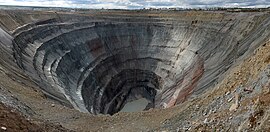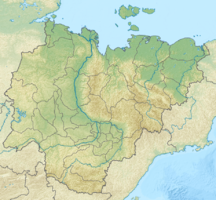Diamond mine Mir
| "Me" | |||
|---|---|---|---|
| General information about the mine | |||
| View into the open pit (2014) | |||
| Mining technology | Open pit mine on 1.13 km² | ||
| Funding / year | 0.3 t | ||
| Funding / total | 18 t diamond | ||
| Information about the mining company | |||
| Operating company | Alrosa | ||
| Start of operation | 1957 | ||
| Funded raw materials | |||
| Degradation of | Diamonds | ||
| Diamonds | |||
| Me | |||
| Mightiness | 800 m | ||
| Raw material content | 0.000000658% | ||
| Greatest depth | 1235 | ||
| overall length | 1200 m | ||
| Geographical location | |||
| Coordinates | 62 ° 31 '45.9 " N , 113 ° 59' 36.7" E | ||
|
|||
| Location | Mirny | ||
| republic | Sakha Republic (Yakutia) | ||
| Country | Russia | ||
| District | Yakutia | ||
The diamond mine "Mir" ( Russian Кимберлитовая алмазная трубка "Мир" , diamond kimberlite vent "Peace" ) is a Russian diamond mine near Mirny in Siberia , in the Republic of Yakutia . It was the largest diamond mine in the Soviet Union .
The Kimberlitschlot was from 1957 to 2001 in open pit mined. With a depth of 525 m and a diameter of 1,200 m on the surface, one of the deepest artificial mine holes on earth was created. Heavy vehicles took two hours to get from the open pit floor to the surface. In 2001 the opencast mining was stopped, since 2009 it has been mined again, but only in underground operation.
discovery
The deposit was discovered on June 13, 1955 by the geologist Juri Chabardin together with his colleagues Jekaterina Jelagina and Viktor Avdejew. During an expedition, the geologists found the volcanic rock kimberlite . Kimberlite is a rarely occurring form of cooled lava and an indicator of the presence of diamonds. Chabardin informed his superiors in Moscow of the discovery using an agreed code word that read: “I smoke the peace pipe.” The Russian word for “peace” is “me”. Hence the name of the pit comes from. Because of their volcanic origin, kimberlite deposits form chimneys , in Russian "трубка" (corresponding to German: pipe). This describes the shape of the open pit that descends steeply like a pipe and possibly also explains the origin of the code word, since a pipe bowl resembles a pipe.
For reasons of self-sufficiency , Stalin encouraged the exploration of diamonds on Soviet territory after the end of World War II . The focus was on the need for diamonds for industrial purposes. The world market for diamonds was then dominated by De Beers , now a subsidiary of Anglo American plc. Stalin felt this dependency was a potential threat. After the smaller “Sarnitsa” deposit discovered shortly before, the “Mir” deposit was the second success of a long-term search and at the same time a major economic success. Mine was the first significant diamond deposit found outside of Africa. For his discovery, Chabardin was honored with the Lenin Prize. Other diamond-bearing kimberlite deposits were later discovered in Yakutia.
Development
The climatic conditions in this part of Siberia represent a major challenge for the development of a deposit. The mean annual temperature is −9.5 ° C, with monthly mean temperatures in January with −35.5 ° C and in July with +15.8 ° C. The permafrost soil is frozen for seven months in winter and in summer it turns into mud in the upper area. The open pit mine began to be explored in 1957. In winter, jet engines were sometimes used to thaw the ground, or it was blown up. The buildings were built on stilts so that they would not sink in the summer. The processing plant was built 20 km away on more stable ground. Machines and vehicles had to be prepared for the harsh winters.
The town of Mirny , which developed into a center for diamond mining, was built in the immediate vicinity of the opencast mine .
advancement
In addition to diamonds for industrial purposes, gemstones were also found in the deposit. In the 1960s, Mir mined 10 million carats (2,000 kg) of diamonds a year, 20% of which were used for jewelry purposes. The diamond content of the deposit decreased with increasing mining depth from initially 4 carats / t to 1.5 to 2 carats / t, which led to a decline in annual production. The largest single diamond to date, at 342.5 carats, was found on December 23, 1980. He was named “XXVI. Congress of the Communist Party of the Soviet Union ”. To stabilize the berms , large areas of plastic were installed. In the 1990s, mining had to be temporarily stopped because the open pit floor was flooded by a water ingress. In the area of the opencast mine hole, stronger turbulence can develop in the air, which is why helicopters are prohibited from flying over the hole for safety reasons.
Water ingress in 2017
On August 4, 2017, there was a massive water ingress. 142 of the 151 miners who had come in on the midday shift were able to leave, another was rescued on August 5th. The search for the remaining eight miners was later discontinued with no results after the water level in the pit continued to rise despite constant pumping. The technical supervisory authority named severe hydrogeological conditions and project decisions as the causes of the accident. There were personnel consequences in the corporate management, the profit of the Alrosa company halved in the financial year.
Export of diamonds

At the beginning of the 1960s, more diamonds were mined in Mir than the Soviet Union needed, so that around 2 million carats could be exported per year. The buyer was the De Beers group of companies, which at that time dominated the world diamond market as a monopoly. De Beers feared that the additional Soviet quantities that were pushing onto the market could upset the world market price. That is why they bought up all of the Soviet export volumes. They sought contact with the Soviet manufacturers in order to obtain more information about the mining, the technology and the capacities. The Soviet side remained very closed. For the Soviet Union, the export of diamonds became an important source of foreign currency. In 1968 Viktor Tikhonov, head of the Mirny Diamond Administration, said: "We call ourselves the country's exchange office."
Owner and current situation
The Mir diamond mine has been owned by the Russian company Alrosa since the 1990s . According to its own information, Alrosa is the largest diamond miner in the world with over a third of world production. The company's shares are traded on the stock exchange, and the state is the largest single shareholder. In 2015 the annual production of the “Mir” mine was around 1.5 million carats. The average diamond grade was still high at 3.43 carats per ton. The reserves of the deposit are estimated at around 40 million carats. Other sources estimate the reserves at 141 million carats.
Web links
- World's Biggest Diamond Mine - Mirny (Mir Mine). Youtube (English)
- photos
Individual evidence
- ↑ a b c A. JA (Bram) Janse: Global rough Diamond Production since 1870. (PDF; 2.2 MB) Table 1 Historic and production data for 24 major diamond mines discovered since 1869. (No longer available online.) Gemological Institute of America, 2007, p. 108 , archived from the original March 21, 2016 ; accessed on September 11, 2016 . Info: The archive link was inserted automatically and has not yet been checked. Please check the original and archive link according to the instructions and then remove this notice.
- ↑ Mir Pipe (Russia, ALROSA). (No longer available online.) In: rough-polished.com. Archived from the original on September 16, 2016 ; accessed on September 11, 2016 . Info: The archive link was inserted automatically and has not yet been checked. Please check the original and archive link according to the instructions and then remove this notice.
- ↑ The largest diamond mines in the world. In: WEG Westphalian precious metal wholesaling and exploitation. February 18, 2015, accessed August 28, 2016 .
- ↑ a b ALROSA (homepage). Retrieved August 16, 2016 .
- ↑ Arno Frank : Gemstones from the ice hell. In: Spiegel. January 2, 2013, accessed August 16, 2016 .
- ↑ a b c A Brief History of the World's Largest Open Pit Diamond Mine. (No longer available online.) Archived from the original on January 1, 2013 ; accessed on August 16, 2016 . Info: The archive link was inserted automatically and has not yet been checked. Please check the original and archive link according to the instructions and then remove this notice.
- ^ A b c Edward Jay Epstein: The Russians are coming. Accessed August 16, 2016 .
- ^ Official website of the city of Mirny. Retrieved August 16, 2016 (Russian).
- ↑ Climate-Data.ORG. Retrieved August 16, 2016 .
- ↑ Jessica Elzea Kogel, Nikhil C. Trivedi, James M. Barker, Stanley T. Krukowski: Industrial Minerals & Rocks: Commodities, Markets, and Uses . 7th edition. SME Society for Mining, Metallurgy, and Exploration, 2006, ISBN 0-87335-233-5 , pp. 424 (English, limited preview in Google Book search).
- ↑ Several workers missing after a mine accident in Russia. In: waz.de. August 4, 2017. Retrieved August 6, 2017 .
- ↑ Russian Rescuers Hunting For Missing ALROSA Miners After Water Floods Mine. In: idexonline.com. August 6, 2017, accessed August 6, 2017 .
- ^ A b André Ballin: ALROSA - Russian diamond giant in crisis. In: Handelsblatt. November 17, 2017. Retrieved November 18, 2017 .
- ↑ Russian diamond giant to review production after accident. In: nationmultimedia.com. August 6, 2017, accessed August 6, 2017 .
- ↑ Desperate battle underway to save remaining 8 miners tapped in flood diamond mine. In: siberiantimes.com. Accessed August 7, 2017 .
- ↑ Miners remain missing at Russia largest diamond pit. In: eblnews.com. August 11, 2017, accessed on August 12, 2017 .
- ↑ Diamond dealer De Beers gives up de facto monopoly. In: The world. July 14, 2000, accessed August 25, 2016 .
- ↑ The world's top 10 biggest diamond mines. October 14, 2013, accessed on August 16, 2016 .

